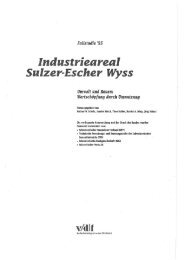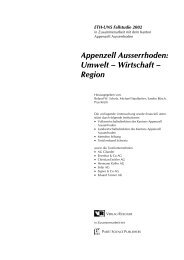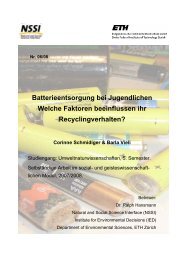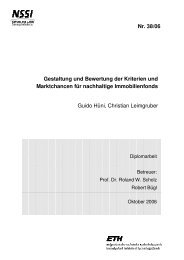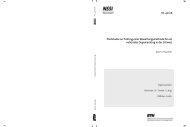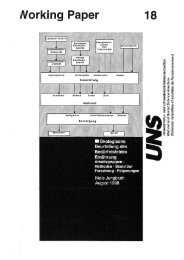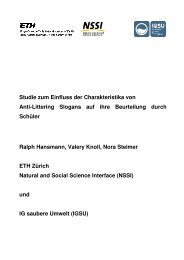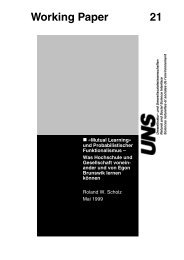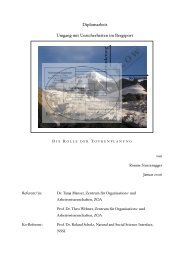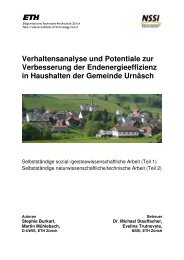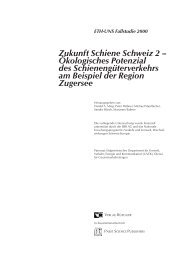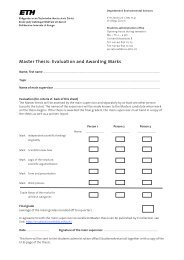Non-road fuel consumption and pollutant emissions ... - BAFU - CH
Non-road fuel consumption and pollutant emissions ... - BAFU - CH
Non-road fuel consumption and pollutant emissions ... - BAFU - CH
You also want an ePaper? Increase the reach of your titles
YUMPU automatically turns print PDFs into web optimized ePapers that Google loves.
4 > Methodology 25<br />
With respect to emission fundamentals for small petrol-powered appliances (chainsaws,<br />
lawn mowers, stampers, vibrators, etc.), a distinction has to be made between<br />
appliances with 4-stroke <strong>and</strong> 2-stroke engines. The relevant legislation distinguishes<br />
between small h<strong>and</strong>-held appliances <strong>and</strong> larger non-h<strong>and</strong>-held machines. In this report,<br />
this distinction is equated with 2-stroke <strong>and</strong> 4-stroke engines.<br />
The first EU emission limit values entered into force in 2004 for most small appliances<br />
(A3-2). Here the main aim was to reduce emission levels of hydrocarbons. From EU II<br />
onwards, similar emission limits apply to both 2-stroke (h<strong>and</strong>-held) <strong>and</strong> 4-stroke (nonh<strong>and</strong>-held)<br />
appliances. Exceptions for certain appliance types have not been taken into<br />
account.<br />
Emission regulations distinguish between two groups:<br />
> Ships<br />
> Recreational craft <strong>and</strong> sports boats.<br />
Due to their size, ships are powered exclusively with diesel engines. Boats can be<br />
equipped with diesel or petrol engines.<br />
Small petrol-powered appliances<br />
Marine machinery<br />
Emission limit values were already specified for both ships <strong>and</strong> boats in 1993 following<br />
the adoption of an ordinance governing shipping on Lake Constance. These limit<br />
values were incorporated into the exhaust regulations for marine engines (SAV) <strong>and</strong><br />
have been binding since 1995 for all bodies of water in Switzerl<strong>and</strong>. In 1996, more<br />
stringent exhaust regulations were specified for Lake Constance, though these were<br />
never incorporated into the SAV <strong>and</strong> are therefore not binding for other bodies of water<br />
in Switzerl<strong>and</strong>.<br />
The SAV was subsequently revised in 2007 within the scope of the co-ordination of<br />
exhaust regulations throughout Europe, <strong>and</strong> this meant that recreational craft, sports<br />
boats etc. could now be used on Switzerl<strong>and</strong>’s bodies of water if they meet the requirements<br />
of Directive 2003/44/EC. In this Directive, the emission limit values for<br />
boats equipped with petrol engines are less stringent than those in the previously valid<br />
SAV I, but as before, in Switzerl<strong>and</strong> boats with 2-stroke engines have to meet the more<br />
stringent exhaust requirements for 4-stroke petrol engines.<br />
Ships with an engine power > 37 kW that are used for commercial purposes (i.e. passenger<br />
ships, ferries <strong>and</strong> cargo ships/barges) have to comply with the emission limit<br />
values stipulated in the ordinance governing shipping on the Rhine, the first level of<br />
which has been binding since 2003. A second level was put into force in July 2007.<br />
Since 2007, ships operated for commercial purposes can also be licensed in accordance<br />
with EU Directive 97/68/EC stage IIIA.<br />
For railway machinery, the International Railway Union (UIC) has been recommending<br />
emission limit values since the 1980s, but these are not legally binding. In the EU,<br />
the exhaust regulations specified in Directive 97/68/EC have applied to railway machinery<br />
since 2005. For emission limit values a distinction is made between locomotives<br />
<strong>and</strong> motor coaches, but for the engine-power classes under consideration in this<br />
report they are identical.<br />
Railway machinery



